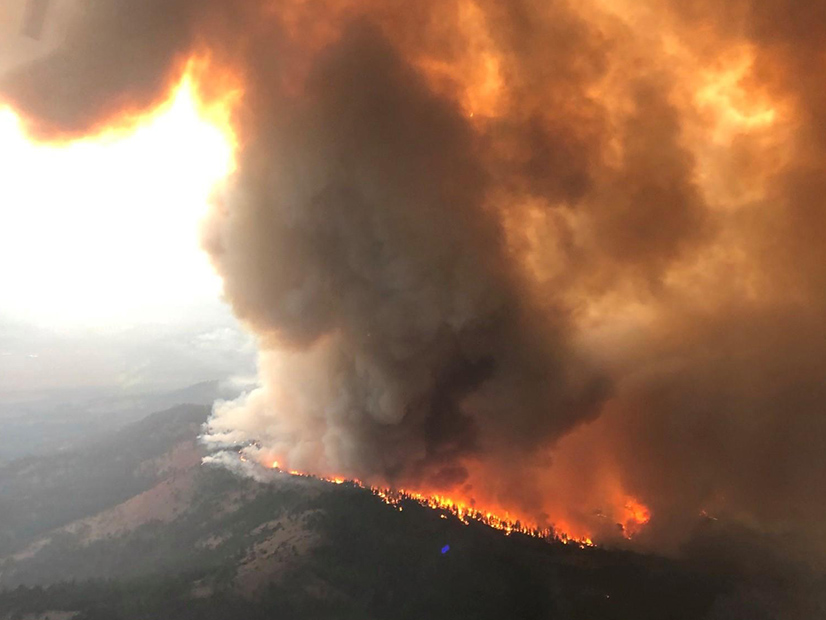
The value of Pacific Gas and Electric’s (NYSE:PCG) fire victims’ trust fund has suffered from news that the utility’s equipment started fires last year and may have ignited the single largest blaze in California history this year, leading its trustee to warn victims that they may not receive the full value of their claims.
The fire victims’ trust, established on July 1, 2020, is $2.5 billion short of expectations, retired state appellate court Justice John Trotter wrote to victims of PG&E-caused fires in 2015, 2017 and 2018 on Wednesday.
Part of PG&E’s bankruptcy reorganization, the settlement “is unique in that its value was not a true lump sum but rather a combination of cash and PG&E stock,” Trotter noted. “It was reported to be $13.5 billion, $6.75 billion in cash and $6.75 billion in stock value. However, that never materialized.
“On the day the trust was established and became owners of approximately 477 million shares of PG&E stock, it was trading at $9 per share, for a value of $4.2 billion, approximately $2.5 billion less than promised. Over the last year, that value has fluctuated and today is close to its value” when the trust was funded, Trotter wrote.
The Dixie Fire has a lot to do with the predicament. By Sunday it had spread to 1,400 square miles, larger than the land mass of Rhode Island or Yosemite National Park. Only last year’s August Complex of fires in Northern California, which topped more than 1 million acres, exceeded the Dixie Fire’s current size. The California Department of Forestry and Fire Protection (Cal Fire) is investigating a PG&E power line as the possible cause of the Dixie Fire.
PG&E stock, which closed at $10.34/share on the day the trust fund was established, has remained below $13 since then. It closed at $9.79 on July 16, before the company informed the California Public Utilities Commission that it may have been responsible for the Dixie Fire. (See PG&E Says Its Line May Have Started Dixie Fire.) Shares closed at $9.15 on Friday.
As of Aug. 31, the trust fund had awarded $2.4 billion in determination notices and made payments of almost $740 million.
Meanwhile, PG&E said last week it had secured approval from the PUC to sell its San Francisco headquarters for $800 million and to return $400 million to ratepayers to lower their bills. PG&E announced in March it was moving across the San Francisco Bay to new headquarters in Oakland. (See PG&E to Sell San Francisco HQ for $800M.)
“In addition to promoting long-term savings for PG&E, the sale of our San Francisco headquarters will help to offset future customer rates at a time when we’re making significant safety and operational investments,” CEO Patti Poppe said in a statement.
In August, the utility asked the CPUC to increase its return on equity from 10.25% to 11% next year, which could increase its profits by $200 million.
The company also announced it would donate $1 million this year to wildfire relief and recovery efforts, including $300,000 to the American Red Cross and $100,000 “to assist communities impacted by the Caldor Fire in El Dorado County.”
The cause of the Caldor Fire, which forced the evacuation of the city of South Lake Tahoe last week, is under investigation.
“We all are blessed by the kindness of the many nonprofit organizations, volunteer fire departments and community groups that are opening their hearts and rolling up their sleeves in service to those who have been displaced temporarily or permanently by these terrible fires,” Poppe said in the statement.
It made no mention of the Dixie Fire or the Zogg Fire, which Cal Fire concluded was started by a tree falling on a PG&E power line. The Zogg Fire killed four people, including a mother and her young daughter unable to escape the flames, in rural Shasta County. (See PG&E Equipment Started Zogg Fire, Investigation Finds.)
If Cal Fire finds a PG&E line started the Dixie Fire, it would mark the fifth year in a row that PG&E’s equipment has been blamed for catastrophic blazes.
Cal Fire blamed the utility’s equipment for starting the devastating Northern California wine country fires of October 2017; the Camp Fire, which killed 85 people and leveled the town of Paradise, in November 2018; and the Kincade Fire, which tore through Sonoma County in October 2019.
The company filed for bankruptcy protection in January 2019 and emerged from Chapter 11 proceedings in June 2020, after agreeing to pay a total of $25.5 billion to fire victims, insurance companies and local governments for the 2015 Butte Fire, the wine country fires and the Camp Fire.
The insurance companies and governments received cash; only fire victims got stock — receiving more than one fifth of PG&E’s outstanding shares.
Before the wine country fires of October 2017, PG&E stock sold at more than $70/share, giving it a market capitalization of $36 billion. The current share price puts the utility’s market value at approximately $20.6 billion.

